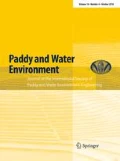Abstract
South Korea’s food self-sufficiency ratio (SSR) dramatically decreased from 56 % in 1980 to 27 % in 2010, due to changes in food production and consumption patterns. Naturally, the changes in food self-sufficiency and consumption patterns will affect the world agricultural trade. This study aims to analyze trends in water footprints (WFs) on the basis of statistics for per capita food consumption in the last 25 years. The WFs for potential water requirements (WFsPWR) were estimated using food production and consumption scenarios for the targets of the SSRs in 2015 and 2020. The WFs for per capita food consumption (WFscap) were estimated at 512.9 m3 (1985) and 822.9 m3 (2010). Cereals and meats accounted for 36.3 and 21.5 % of the total WFscap in 1985, and 18.3 and 38.6 % in 2010, respectively. This implies that with economic development, Korea’s dietary patterns have changed from cereal to meat-oriented. To achieve the targets of 52 % (2015) and 55 % (2020) food SSR based on calories, additional WFsPWR are estimated to be 1255.5 Mm3 (2015) and 1923.9 Mm3 (2020). Results of this study are expected to be a useful basis for making long-term policies for sustainable agricultural production and water management from technical and social perspectives.







Similar content being viewed by others
References
Allan JA (1998) Virtual water: a strategic resource global solutions to regional deficits. Ground Water 36:545–546
Biewald A, Rolinski S, Lotze-Campen H, Schmitz C, Dietrich JP (2014) Valuing the impact of trade on local blue water. Ecol Econ 101:43–53
Chapagain AK, Hoekstra AY (2011) The blue, green, and grey water footprint of rice from production and consumption perspectives. Ecol Econ 70:749–758
Dalin C, Hanasaki N, Qiu H, Mauzerall DL, Rodriguez-Iturbe I (2014) Water resources transfers through Chinese interprovincial and foreign food trade. Proc Natl Acad Sci 111(27):9774–9779
D’Odorico P, Carr JA, Laio F, Ridolfi L, Vandoni S (2014) Feeding humanity through global food trade. Earth’s Future 2(9):458–469
Duarte R, Pinilla V, Serrano A (2014) The water footprint of the Spanish agricultural sector: 1860–2010. Ecol Econ 108:200–207
Food and Agriculture Organization of the United Nations (FAO) (2006) World agriculture: towards 2030/2050. Interim Report, Rome
Hoekstra AY, Chapagain AK (2007) Water footprints of nations: water use by people as a function of their consumption pattern. Water Resour Manag 21(1):35–48
Hoekstra AY, Mekonnen MM (2012) The water footprint of humanity. Proc Natl Acad Sci 109(9):3232–3237
Hoekstra AY, Chapagain AK, Aldaya MM, Mekonnen MM (2011) The water footprint assessment manual: setting the global standard. Earthscan, London
Intergovernmental Panel on Climate Change (IPCC) (2007) Climate change impacts, adaption and vulnerability. Cambridge University Press, Cambridge
Korea Rural Economic Institute (KREI) (2011) Food balance sheet. Korea Rural Economic Institute, Seoul (in Korean)
Korea Rural Economic Institute (KREI), Ministry for Food, Agriculture, Forestry and Fisheries (MIFAFF) (2011) Report on the conceptualization of food self-sufficiency ratio and adjustment of its target in Korea. Korea Rural Economic Institute, Seoul (in Korean)
Lee SH, Yoo SH, Choi JY, Kim YD, Shin A (2015) Estimation of water footprint for livestock products in Korea. J Korean Soc Agric Eng 49(2):61–74 (in Korean)
Liu J, Savenije HHG (2008) Food consumption patterns and their effect on water requirement in China. Hydrol Earth Syst Sci 12:887–898
Mekonnen MM, Hoekstra AY (2010a) The green, blue and grey water footprint of crops and derived crop products. Value of Water Research Report Series No. 47. UNESCO-IHE Institute for Water Education
Mekonnen MM, Hoekstra AY (2010b) The green, blue and grey water footprint of farm animals and animal products. Value of Water Research Report Series No. 48. UNESCO-IHE Institute for Water Education
Mekonnen MM, Hoekstra AY (2012) A global assessment of the water footprint of farm animal products. Ecosystems 15(3):401–415
Ministry for Food, Agriculture, Forestry and Fisheries (MIFAFF) (2011) Major statistics for food, agriculture, forestry and fisheries. Ministry for Food, Agriculture, Forestry and Fisheries, Gwacheon (in Korean)
Ministry of Construction and Transportation (MCT) (2006) Comprehensive water resources plan-water vision 2020. Ministry of Construction and Transportation, Gwacheon (in Korean)
Oki T (2005) The hydrologic cycles and global circulation. In: Anderson MG (ed) Encyclopaedia of hydrological sciences. Wiley, Chichester
Orlowsky B, Hoekstra AY, Gudmundsson L, Seneviratne SI (2014) Todayʼs virtual water consumption and trade under future water scarcity. Environ Res Lett 9(7):074007
Schyns JF, Hoekstra AY (2014) The added value of Water Footprint Assessment for national water policy: a case study for Morocco. PLoS One 9(6):e99705
The World Bank (2012) Trends in the global demand for food. http://go.worldbank.org/D8VH8Y32D0. Accessed 24 Feb 2012
Yoo SH, Choi JY, Kim TG, Im JB, Chun CH (2009) Estimation of crop virtual water in Korea. J Korea Water Resour Assoc 42(11):911–920 (in Korean)
Yoo SH, Choi JY, Nam WH, Hong E (2012) Analysis of design water requirement of paddy rice using frequency analysis affected by climate change in South Korea. Agric Water Manag 112(9):33–42
Yoo SH, Choi JY, Lee SH, Kim TG (2014a) Estimating water footprint of paddy rice in Korea. Paddy Water Environ 12(1):43–54 (in Korean)
Yoo SH, Lee SH, Choi JY (2014b) Estimating water footprint for upland crop production in Korea. J Korean Soc Agric Eng 56(3):65–74 (in Korean)
Author information
Authors and Affiliations
Corresponding author
Rights and permissions
About this article
Cite this article
Yoo, SH., Lee, SH., Choi, JY. et al. Estimation of potential water requirements using water footprint for the target of food self-sufficiency in South Korea. Paddy Water Environ 14, 259–269 (2016). https://doi.org/10.1007/s10333-015-0495-x
Received:
Revised:
Accepted:
Published:
Issue Date:
DOI: https://doi.org/10.1007/s10333-015-0495-x




